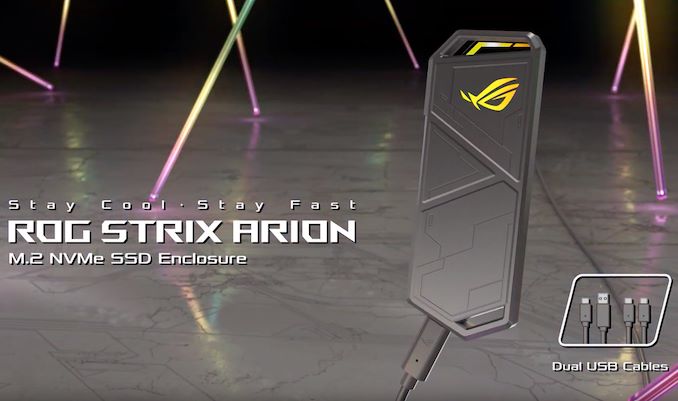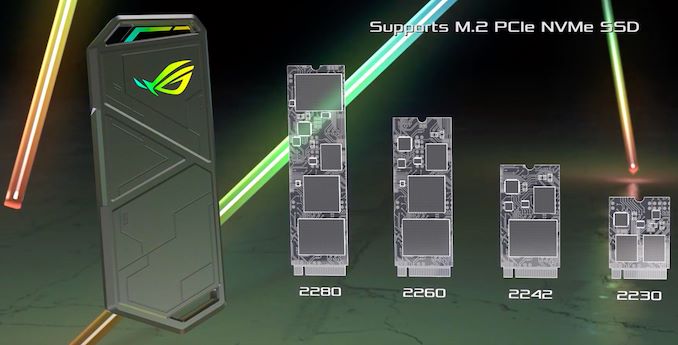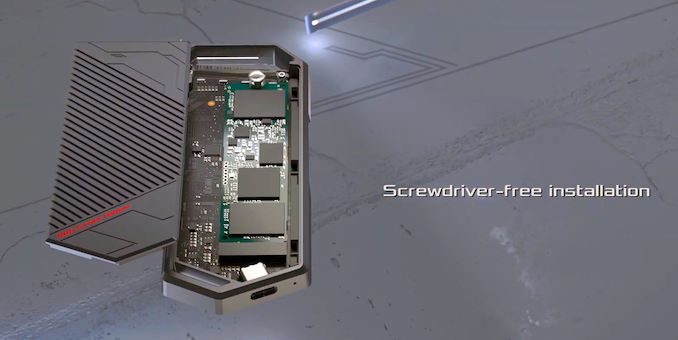ASUS Shows Off ROG Strix Arion: A RGB USB 3.2 Gen 2 M.2 SSD Enclosure
by Anton Shilov on September 27, 2019 4:00 PM EST- Posted in
- Storage
- SSDs
- Asus
- ROG
- External SSDs

Having extended its ROG products family from motherboards and graphics cards to pretty much everything that could interest demanding gamers and prosumers with deep pockets, ASUS continues to find ways to further expand the ROG lineup. This week the company showcased its upcoming ROG Strix Arion enclosure for M.2 SSDs that features a USB 3.2 Gen 2 interface along with Aura Sync RGB lighting.
The ASUS ROG Strix Arion SSD chassis is compatible with all M.2-2280 (and smaller) drives featuring a PCIe 3.0 interface and do not have a pre-installed heat spreader. The SSD can be installed without using a screwdriver, so the assembly should be quite easy. The enclosure is made of aluminum and has thermal pads in a bid to ensure proper heat dissipation and consistent performance. The unit is bus powered and has a USB Type-C interface, but ASUS will ship it with a USB-C-to-USB-C as well as a USB-C-to-USB-A cable to maximize compatibility.
ASUS does not disclose which USB 3.2 Gen 2-to-PCIe Gen 3 bridge it uses, so we cannot make any assumptions regarding real-world performance of a ROG Strix Arion-enabled storage device. It's possible this is using Realtek's new RTL9210 bridge, since Realtek was showing off the RGB LED driver capabilities of that bridge recently at Flash Memory Summit. Anyhow, in the best-case scenario it will feature up to 1.25 GB/s raw throughput.
Traditionally for any Republic of Gamers product, the ROG Strix Arion features a rather unorthodox design with Mayan patterns. Meanwhile, following the latest trends, the device has RGB LEDs and supports the ASUS Aura Sync lighting and therefore can synchronize its lighting with other components from ASUS.
Considering the fact that ASUS is demonstrating the ROG Strix Arion on its YouTube channel, expect the device to be available in the foreseeable future. Unfortunately, we have no idea about pricing of the unit, though without any doubts this is a premium chassis for M.2 SSDs.
Related Reading:
- ASUS Unveils FX External HDDs with Aura Sync RGB & AES-256 Encryption
- MyDigitalSSD M2X M.2 NVMe SSD Enclosure Review - A PCIe to USB Storage Bridge
- ASUS ROG Phone II Ultimate Edition: 120 Hz, 12 GB / 1 TB with 6000 mAh
- It Hurtz a Lot: ASUS's New 300 Hz Laptops
- ASUS Unveils the ROG Rampage VI Extreme Encore X299 Motherboard
- ASUS Dominus Extreme BIOS has Cascade Lake Xeon W-3275 & W-3275M Support
- NVIDIA G-Sync Ultimate Mini LED Monitors: From Acer & ASUS Later in 2019
Source: ASUS (via Hermitage Akihabara)












21 Comments
View All Comments
abufrejoval - Friday, September 27, 2019 - link
If the price were right, I'd simply put it into my tool chest.With SATA 2.5" SSDs (and HDDs), life was perfect for a while, because I use these carrier-less dual hot-swap bays on all my PCs and I have similar USB3 cases, which allow for screw-free mounting of SATA devices for notebooks.
I could move drives between systems super easily, do imaging forth and back the file server: Complete flexibility!
With all this M.2 and NVMe stuff things got way more complicated and often enough I was forced to balance ease-of-use vs. the extra performance (or smaller size) of this new interface and form factor.
This would allow for some flexibility again, because USB3 at least up to 5Gbit, is fairly standard now and good enough for imaging drives, when you're not doing it all day long.
Still wished U.2 wasn't such a nasty markup on SATA in terms of general pricing and you could have a chassis that supports both U.2 and USB3/4 mounting around the €50 mark.
Death666Angel - Saturday, September 28, 2019 - link
M.2 PCIe (or SATA) to USB cases have been around for quite a while (SATA for longer than PCIe). If you can get to the M.2 slot of the machine easily, ease of use should be the same as normal SATA drives (one of my M.2 slots is covered by the CPU cooler and the GPU and the other is covered by the GPU cooler). :D The increased speed should make up for it in the long run. I'm personally pretty happy with it, the over 1 GB/s transfer speed of my internal storage is pretty nice and not having any more power or data cables messing up my build is cool. But I also build in small systems and not giant towers where those cables can be more hidden and better routed.eek2121 - Sunday, September 29, 2019 - link
I'm not a fan of the m.2 form factor honestly. There are only so many places you can stick an m.2 slow and only so many PCIE lanes (this coming from a guy with Threadripper). A SATA case can hold over a dozen 2.5" drives and you can usually plug at least half of those into the motherboard, but you only get 2-4 m.2 slots unless you buy an expansion card. I also wonder what kind of power limitations we run into when it comes to an m.2 drive. Since it runs off the motherboard's power, I imagine we'll start to see issues with PCIE4 or PCIE5 and boards with several m.2 slots. As much as I despise having to run a cable from the PSU everywhere, I think we would have been better off with SATA Express and succesors to it.Targon - Monday, September 30, 2019 - link
There were dedicated PCIe lanes for the m.2 slot on Socket AM4, so there shouldn't have been a problem with those. It's more an issue with motherboard real estate for where to put the M.2 slot.erinadreno - Friday, September 27, 2019 - link
I'd be surprised if the controller is not made by Jmicron. I can't think of another company that bothers making USB to pcie bridge chip.erinadreno - Friday, September 27, 2019 - link
My bad, it literally says in the article "RTL9210". I'm still a bit sceptical about ASUS tho.Targon - Monday, September 30, 2019 - link
Asus ROG tends to be good quality, and it's only the RMA process for defective products that should make people concerned.RohitMathew - Saturday, September 28, 2019 - link
The Realteks website show the RTL9210 bridge to be USB3.1 Gen2 not USB3.2Death666Angel - Saturday, September 28, 2019 - link
Then Realtek doesn't know about the USB standard themselves. USB 3.1 Gen 2 is now known as USB 3.2 Gen 2, because reasons. Same as USB 3.0 now being USB 3.2 Gen 1 and the realy next generation being USB 3.2 Gen 2x2. At this point it is honestly better to just refer to them by bandwidth (5 Gb/s, 10 Gb/s or 2x10Gb/s).Ashinjuka - Saturday, September 28, 2019 - link
As mind-numbingly dumb as the USB 3 nomenclature has become, who can really blame Realtek?